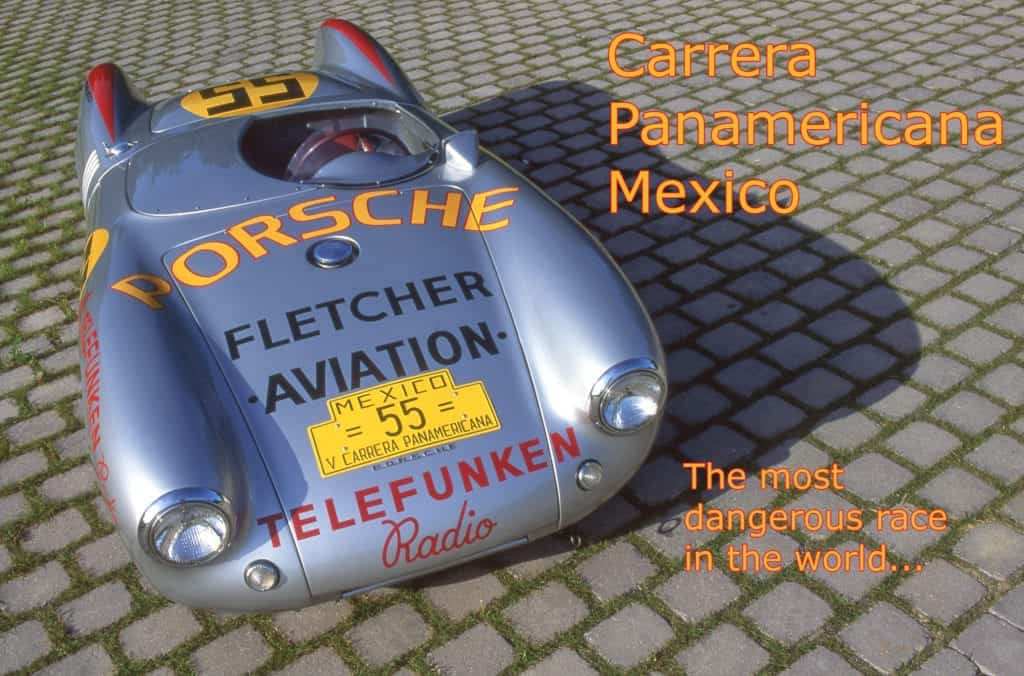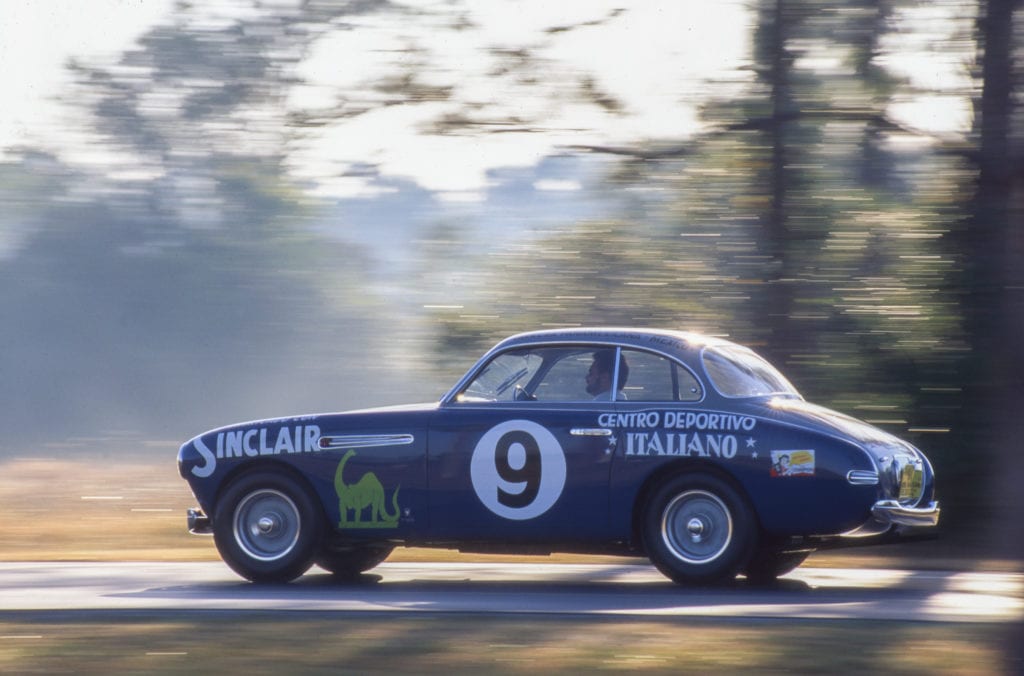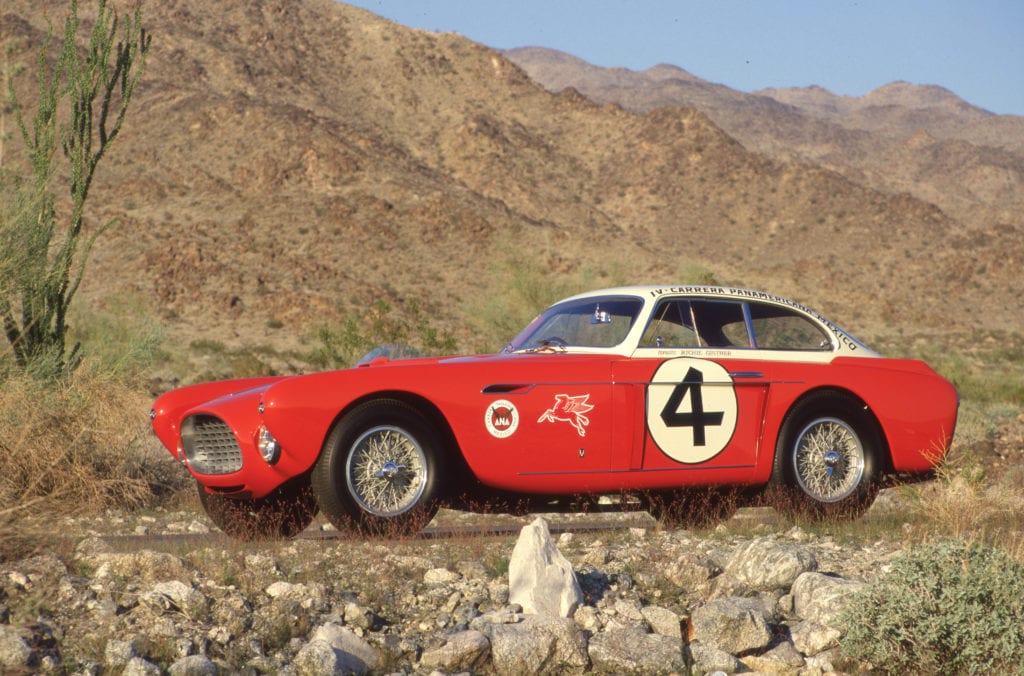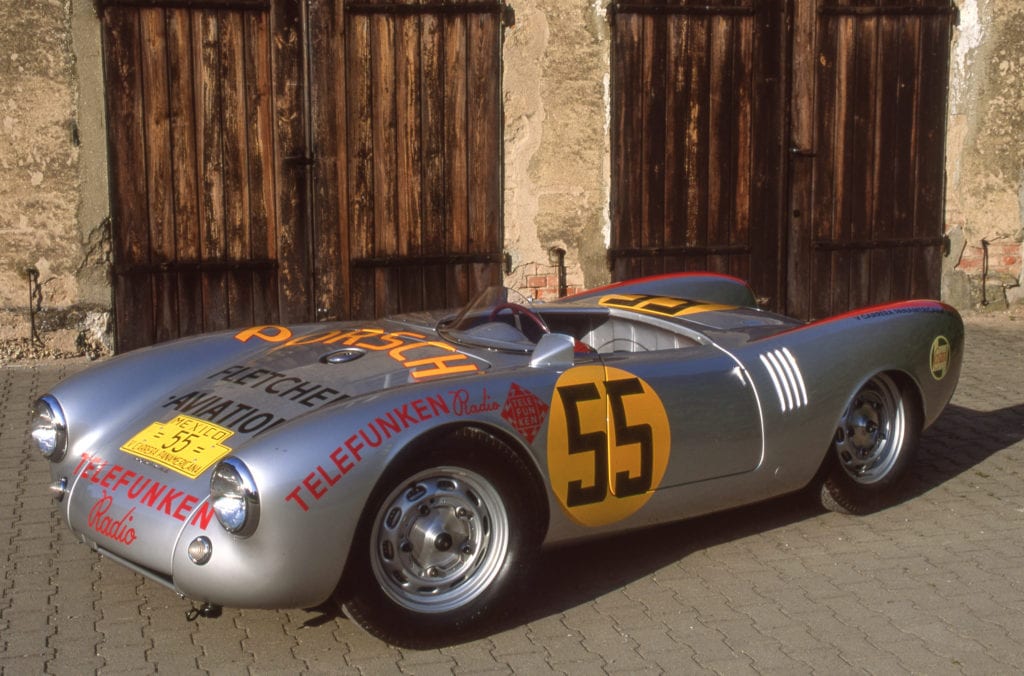Carrera Panamericana

It’s perhaps the longest “motorable” highway in the world. Only the Darién Gap on the Panama – Colombia frontier prevents the Pan American highway from stretching unbroken from Prudhoe Bay, Alaska some 19,000 miles south, well into South America.
Conceived in the late 1930s, the first Latin American country to complete its stretch of the highway was Mexico in 1950. What better way to celebrate than an automobile race?
Mexico’s Carrera Panamericana began modestly and became one of the world’s most famous automobile races. It was also one of the most deadly, which abetted its undoing. The grand variety of entries ranged from big American stock cars to pure-bred European sports racing machines.
Revs Institute in Naples, Fla. is celebrating the race and the cars that ran it with a display of the 1954 class-winning 4,200-pound Lincoln Capri and another one-time entrant, a Porsche 550 Spyder weighing a mere 1,200 pounds. (The special display begins Dec. 1) A 5203-cc V-8 versus a 1498-cc flat-4.

Here’s a history of the event and how progress in race cars — note the ever-faster finishing times — and a mounting death toll killed it after only five years.
1950
A major reason for the Carrera Panamericana was to prove Americans in big sedans could cruise the highway in comfort and safety.
With that emphasis on touring, the initial entry was limited to sedans with seating for five. Other than five “foreign” cars, the starting field looked like an American showroom. The oddball? A Cord 812.
Buicks, Chevrolets, Hudsons, Lincolns, et al made up the 126 starters in May. Flagged off just over the U.S. border in Ciudad Juárez, they raced south to the Guatemala-Mexico border. Roads varied from twisty mountain sections to fast straightaways, with altitudes ranging between 328 and 10,482 feet. Another struggle was the required, questionable local gasoline. (And, yes, the drinking water.)
Drivers included Bill France, Curtis Turner and Johnny Mantz. The winner? Herschel McGriff in an Oldsmobile 88, who completed the nine stages of 2046 miles in 27 hours, 34 minutes, 25 seconds.

1951
The event was run south-north and moved to November. Again the majority of the entries were American sedans, but entrants also included Lancias, a Delahaye, an Alfa Romeo and two Jaguar MK IIs, one driven by Bobby and Jerry Unser.
And there were a pair of what Ferrari’s U.S. importer, Luigi Chinetti, called, “false four-seaters” — Ferrari 212 Inter Vignales that had a 2+2 layout (Chinetti’s with Jeep rear springs) were allowed to compete. They won: Piero Taruffi and Chinetti 1st, Alberto Ascari and Gigi Villoresi 2nd. The winner’s time: Eight stages of 1,934 miles in 21 hours, 57 minutes, 52 seconds.

1952
Increasing interest from European automakers meant two classes: sports cars and stock cars. Mercedes-Benz brought its new 300 SL and finished 1-2. The winners, Karl Kling and Hans Klenk, created a racing legend when a vulture crashed through their windshield. Despite running, um, afowl, the drivers were unharmed.
Indicating the Carrera’s increasing international flavor, the top six finishers were from Mercedes, Ferrari and Lancia. Chuck Stevenson was in 7th, winning the stock car class in a Lincoln Capri. Winner’s time: Eight stages of 1,934 miles in 18 hours, 51 minutes, 19 seconds.

1953
The Carrera was now part of the Federation Internationale de l’Automobile World SportsCar Championship, with the likes of the 24 Hour of Le Mans. That brought more classes: sports cars over and under 1600-cc and “Turismo Internacional” vehicles (American stock cars) with engines both more and less than 3500 cc.
The 172 competing cars included Lancia’s powerful D24 sports racers, seven privately-entered Ferraris, ten Porsches with two factory 550 Spyders and 19 powerful Lincoln Capris.
Phil Hill once recalled that after crashing in 1953, he and Richie Ginther tried to warn approaching racers of the hazardous corner by waving their arms. They were forced back at rifle point by soldiers. The crowd was enjoying the accidents…why spoil the fun? This was the deadliest Carrera. Nine people died, including six onlookers in one accident involving driver Mickey Thompson. (The crash wasn’t his fault.)
Juan Manuel Fangio led a 1-2-3 Lancia overall win. A Porsche 550 Coupe took the under 1600-cc class. Lincoln Capris dominated the big sedan division, Chuck Stevenson was again the winner, finishing 7th overall. Winner’s time: Eight stages of 1,911 miles in 18 hours, 11 minutes.
The most memorable entry? Famed hot rodder AK Miller in, his Caballo de Hiero-Oldsmobile hot rod, finishing an impressive 14th.

1954
Of the 150 starters, 46 were from Europe. Many were factory entries, but none were from Ferrari. It ignored the Mexican event, but its customers did not and Ferraris finished 1-2. Umberto Maglioli drove solo to the win, with Phil Hill and Richie Ginther in 2nd. Possibly the most impressive finishers were under- 1500-cc Porsche 550 Spyders in 3rd and 4th overall. Ray Crawford drove a Lincoln Capri (the one in Revs Institute display) to 9th and the stock car win.
To prove the reliability of the Volkswagen Beetle, Mexico’s VW distributor entered seven of them in the 1954 Carrera. They ran bumper-to-bumper, a la NASCAR stock cars at Daytona. Thanks to that drafting, they finished 78th-79th-80th and then 82nd-83rd-84th-85th. The little Beetles that could.
Winner’s time: Eight stages of 1,908 miles in 17 hours, 40 minutes, 26 seconds. That’s ten hours (hours!) faster than the 1950 winning time.
The 1955 Carrera, scheduled for that December, never happened. One reason was economics: the costs of keeping the roads in condition for racing, of manning the long circuit with organizers and police, and of providing prize money. Also, the original purpose of the race, to prove the highway suitable for family cars, was fulfilled. And the race hindered about a week of commercial traffic.
Then there were the deaths. Twenty-seven spectators and participants had died in the five Carreras. The Le Mans disaster in June 1955, when more than 80 were killed, was added proof that the ever-growing speed of competition cars was out-racing the condition of their circuits.
The Carrera Panamericana did boost motorsports in Mexico. The race’s legacy continues today as La Carrera Panamericana, an open road rally commemorated in a video by Pink Floyd.
One of the best modern day Formula 1 circuits is Mexico’s Autodromo Hermanos Rodríguez, named for famed racing brothers Pedro and Ricardo Rodríguez. Mexican driver Sergio Perez is enjoying success on today’s F1 grid. And recently, Daniel Suárez became NASCAR’s Xfinity champ, the first Latin American to win a series title.
Ole!